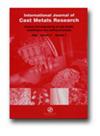AA6xxx轧制产品表面起泡形成机理:微观结构表征、超声分析和轧制试验结果
IF 1.1
4区 材料科学
Q3 METALLURGY & METALLURGICAL ENGINEERING
International Journal of Cast Metals Research
Pub Date : 2022-11-02
DOI:10.1080/13640461.2023.2172372
引用次数: 0
摘要
研究了6xxx系列铝轧制产品表面起泡缺陷的产生原因。在AA6xxx Al轧制板材的表面上观察到与轧制方向一致的起泡缺陷。研究表明,通过超声波测试和金相分析确定的铸锭内部的孔隙率和微小的微观结构不均匀性不是这些表面缺陷的来源。中试轧制试验表明,泡罩缺陷与铸件内部纵向裂纹有关。铸锭中的短边裂纹被薄铝氧化物层覆盖,在轧制过程后没有愈合,并保持部分开放。在热机械过程的后期阶段,未愈合的裂纹充当H2沉淀的成核位点,这随后是由AA6xxx Al轧制板材上的表面气泡引起的。本文章由计算机程序翻译,如有差异,请以英文原文为准。
Formation mechanisms of surface blistering in AA6xxx rolled products: microstructure characterisation, ultrasonic analysis, and rolling tests results
ABSTRACT The source of surface blister defect in 6xxx series Al rolled products was studied. A blister defect, aligned with the rolling direction, was observed on the surface of the AA6xxx Al rolled sheets. It was indicated that the porosities and small microstructural inhomogeneities inside the cast ingots, identified by ultrasonic tests and metallography analysis, were not the origin of these surface defects. Pilot scale rolling trials indicated that the blister defects were correlated with the longitudinal internal casting cracks. The short side cracks in the cast ingots, covered by a thin Al oxide layer, were not healed and remained partially open after the rolling process. The unhealed cracks served as the nucleation sites for H2 precipitation during the later stages of the thermomechanical process, which were subsequently resulted from surface blisters on the AA6xxx Al rolled sheets.
求助全文
通过发布文献求助,成功后即可免费获取论文全文。
去求助
来源期刊
CiteScore
2.70
自引率
7.10%
发文量
14
审稿时长
7.5 months
期刊介绍:
The International Journal of Cast Metals Research is devoted to the dissemination of peer reviewed information on the science and engineering of cast metals, solidification and casting processes. Assured production of high integrity castings requires an integrated approach that optimises casting, mould and gating design; mould materials and binders; alloy composition and microstructure; metal melting, modification and handling; dimensional control; and finishing and post-treatment of the casting. The Journal reports advances in both the fundamental science and materials and production engineering contributing to the successful manufacture of fit for purpose castings.

 求助内容:
求助内容: 应助结果提醒方式:
应助结果提醒方式:


